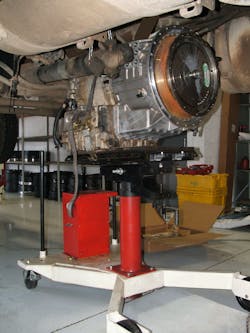Stertil-Koni Makes Advances in Transmission Jacks Lift Productivity
As buses and trucks grow ever larger and more complex, busy maintenance shops — particularly those serving transit agencies, public works departments and school districts — are demanding new technologies that make the work environment both more safe and productive, according to Stertil-Koni.
One of the most pressing needs remains: how to efficiently service truck and bus transmissions. The challenge is big.
“They are extremely heavy pieces of machinery (anywhere, from 1,500-pounds to 3,000-pounds each) that, when service is required, have to be manually removed from the undercarriage of the vehicle,” noted Peter Bowers, technical sales support manager at Stertil-Koni.
Enter the latest technologies that have been incorporated into the good old fashioned transmission jack (TJ), which is designed for the removal and installation of transmissions, differentials and other components on heavy vehicles. They have proved to be ideal for servicing buses, trucks, industrial vehicles and a broad range of construction equipment.
Now, the powerful TJ is bringing new capabilities to the shop floor, all courtesy of the latest advances:
- Lifting capacities have been increased
- Newer “X” shaped base frames improve stability and access
- Base frames have been broadened for further steadiness
- Fine-tuning adjustments to place the TJ in the optimal position are now available
- Hydraulics have been added to make one-touch lifting and lowering a snap.
Continued Bowers, “When you work on heavy duty vehicles, safety is mission #1 at Stertil-Koni. Our transmission jacks have the highest capacity in the industry. What’s more, the fully-hydraulic telescopic system can support 3,500-pounds at a speed of 30-inches per minute with a lifting range of 37-to 74-inches. Further, full-swivel dolly wheels ensure a tight turning radius with mechanical locks for safety.”
Stertil-Koni TJs are constructed with heavy steel framing, assembled to the highest industry standards and are available in two formats – battery-operated and pneumatic. The battery-operated jack can be charged overnight and used without cables. The pneumatic jack has an attached air hose to keep it working. Previously, transmission jacks were manually hand-pumped, much like a car jack.
The adaptable transmission jack can be used for a variety of service jobs in transit or fleet maintenance facilities, including the servicing of:
- Transmissions
- Diesel Particulate Filters
- Gas Tanks
- Rear and Front Differentials
- Secondary auxiliary tasks that require lifting heavy loads in tight spaces.
In conclusion, Bowers added, “TJs have become an absolutely essential piece of equipment for today’s modern, heavy duty vehicle maintenance facilities. They enhance safety, improve ergonomics and boost productivity – every time.”
